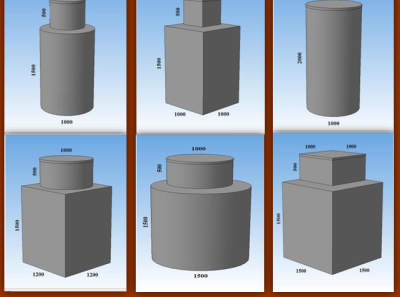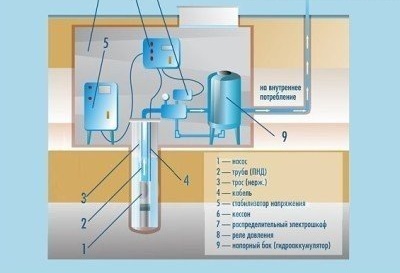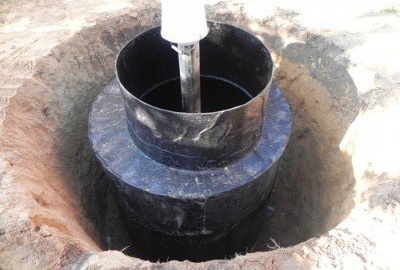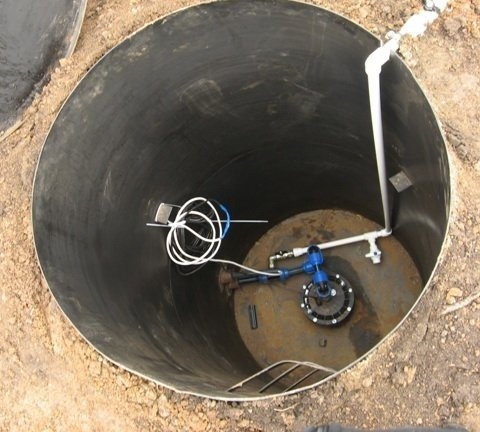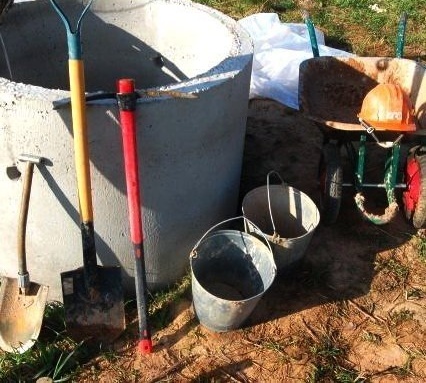Do-it-yourself water well setup: work rules
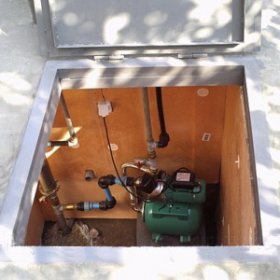
Organization of autonomous water supply is a very troublesome and responsible business. It includes a whole range of measures for drilling the well and its arrangement. If the first is better to entrust to specialists, especially when it is planned to use the resulting water as drinking water, then the second is quite possible to do it yourself. It should be borne in mind that the arrangement of a well for water involves the competent installation of special devices that will ensure a constant supply of water. Therefore, before proceeding with installation, it is worth getting acquainted with their design and principle of operation.
Content
Types and features of installation of caissons
The uninterrupted operation of the well is designed to provide a caisson, an insulated waterproof container with the necessary equipment inside.
Typically, a pump, shutoff valves, measuring instruments, automation, filters, etc. are mounted in it. Buildings are being made of different materials. The most common are:
- Plastic They are distinguished by excellent thermal insulation, which allows even without additional warming to maintain the temperature inside the caisson at 5C. Durability, excellent waterproofing characteristics, which makes it possible to avoid the additional costs of insulation work at an affordable price, especially in comparison with other options. In addition, mounting the system is quite simple due to its low weight. The main disadvantage is low rigidity, which can provoke deformation of the structure and damage to equipment. However, it is easy to cope with it, filling the tank around the perimeter with cement mortar with a layer of 80-100 mm.
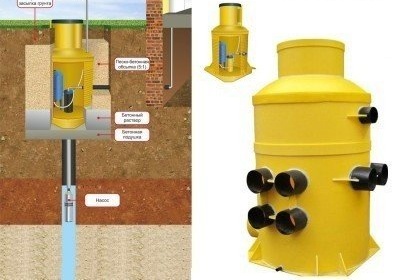
Plastic caissons have excellent thermal insulation, which allows you to install them without additional insulation
- Steel. Most often, the arrangement of a water well is made with just such a design. The material allows you to make a caisson of any desired shape, without any special effort. It will be enough just to weld the parts together and process the structure from the inside and outside with a special anti-corrosion coating. For high-quality capacity, 4 mm thick metal will be quite enough. You can also find ready-made structures on sale, but their purchase will cost much more than independent manufacture.
- Reinforced concrete. Very strong and durable installations, previously extremely common. Due to their shortcomings, they are used much less often today. Their cost is very high, and installation requires special equipment, due to the large weight of the equipment. For the same reason, over time, the concrete caisson sags, deforming the pipelines inside it.
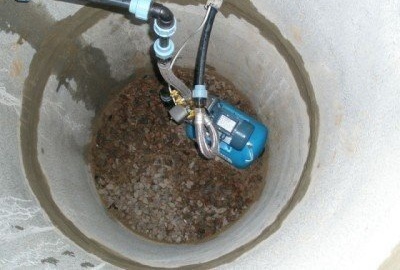
Concrete has insufficient thermal insulation, which can cause freezing of water in the pump in severe frosts, and poor waterproofing, since the concrete is hygroscopic
Here is an example diagram of installing equipment in a caisson and summing up communications:
If you are planning to do the well completion yourself, you should get acquainted with the stages of installation of the caisson. They are almost the same for all types of structures, with small nuances that depend on the material of the equipment. Consider the steps for installing a steel tank:
-
- Preparation of the pit. We dig a hole, the diameter of which exceeds the diameter of the caisson by 20-30 cm. The depth must be calculated so that the neck of the structure rises above the ground by about 15 cm. In this way, flooding of the tank during floods and heavy rainfall will be avoided.
- Installation of casing liner. We make a hole in the bottom of the tank. It can be traditionally located in the center or shifted as needed for the installation of equipment. A sleeve 10-15 cm long must be welded to the hole. Its diameter should be larger than the diameter of the casing. Be sure to check that the sleeve is easily put on the pipe.
- Installation of nipples for the output of water pipes. We weld them into the wall of the tank.
- Installation of a caisson. We cut the casing at ground level. We place the container on the bars above the pit so that the sleeve on the bottom of the container "gets dressed" on the pipe. Check that the axes of the caisson and the casing coincide exactly, then carefully remove the bars and carefully lower the structure along the casing down. We install the container in the pit strictly vertically and fix it with bars. We weld the pipe to the bottom, sealing the caisson. Through the nipples we bring water pipes into the structure.
Backfill facilities.
It should be noted that, in principle, it is possible to equip a well without a caisson, but only if there is a heated building not far from it, in which the equipment is located.
The convenience of such a system is undeniable - all nodes are easily accessible. However, the disadvantages are also significant: it takes up a lot of space in the room and most often makes a lot of noise.
You will find more detailed installation instructions for the caisson for the well in our next material:https://aquatech.tomathouse.com/en/vodosnab/kolod-skvaj/kesson-dlya-skvazhiny-svoimi-rukami.html.
Selection and installation of a well pump
The selection of the pump is the most important stage in the arrangement of autonomous water supply. Equipment should be selected taking into account many factors: the degree of load on the well, the desired water flow rate, the depth of the aquifer, etc. In addition, the types of mechanisms should be taken into account: for wells with a depth of less than 9 m, a self-priming surface device is usually chosen, for marks below 9 m, install special borehole pumps.
In the future, the arrangement of a well in a country house or in a private house involves the installation of a device for supplying water. It consists in the fact that the pump sinks into the well at a mark located below the static water level. Together with it should be omitted:
- a cable supplying energy to the electric motor of the device;
- plastic pipe for water supply;
- stainless strong safety rope for the pump.
The cable is firmly fixed to the head of the well. In case automatic control systems and water-lifting equipment are supposed to be placed in the house, the cable and pipe for water supply are brought directly into the room. You can also put all the equipment inside the caisson, but then its area should be larger.
Accumulator and automatic control systems
When calculating how to equip a well with water, you need to remember about the hydraulic accumulator, without which the system will not be able to work efficiently.It is a pressure tank designed to reduce the load on the pump and maintain the pressure in the system at a predetermined level. Accumulator collects a certain supply of water, upon reduction of which the pump automatically turns on to resume the reserve. The tank volume depends on many factors and can vary from 10 to 1000 liters. The equipment is installed either in the caisson or in the basement.
The last to install and configure automatic control systems. Most often, this is a relay that maintains the necessary pressure level in the system, and an automation control panel.
The device is necessary to control the operation of the thermal relay, pressure switch, dry-running sensor, to start and stop the pump. Also, fuses built into the remote control protect the equipment from possible power surges.
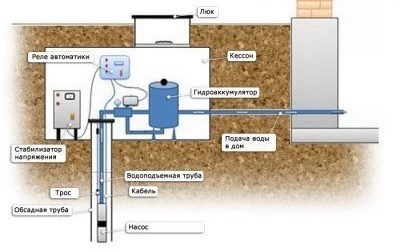
The hydraulic accumulator can be installed both in the caisson and in the building - it all depends on the preferences of the owner and the specifics of the system
In our next article, you will find out what parameters are important to consider when choosing pumping equipment for a well:https://aquatech.tomathouse.com/en/vodosnab/kolod-skvaj/kak-vybrat-nasos-dlya-skvazhiny.html.
Thinking about how to equip a well, you need to soberly assess your capabilities. This process is quite complex and requires special knowledge and skills. If you have doubts about your own strengths, it is worth entrusting the work to professionals. They will qualitatively drill and equip a well, the owner of which will only have the pleasure of using autonomous water supply.
